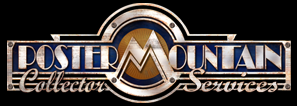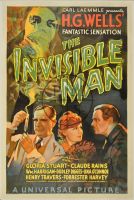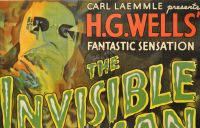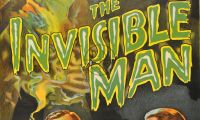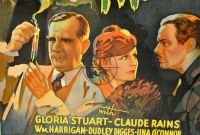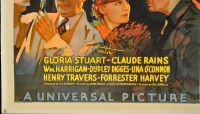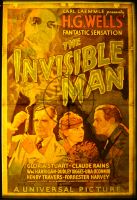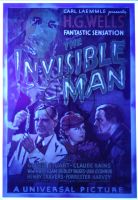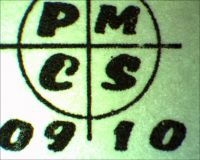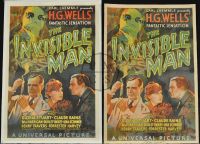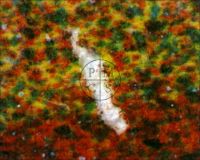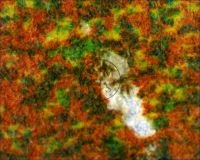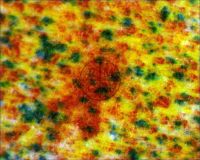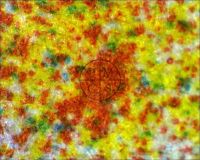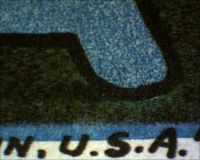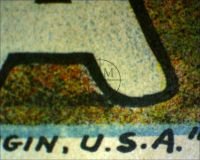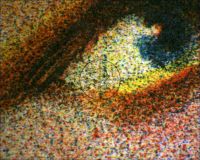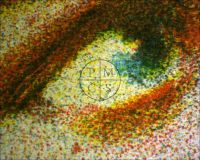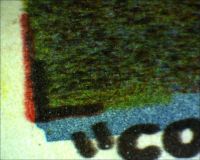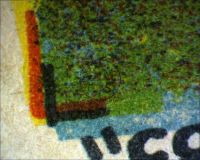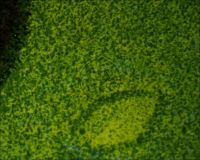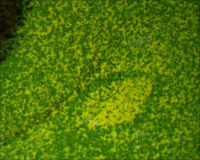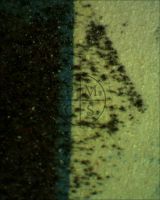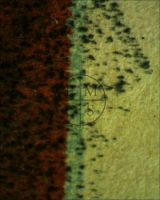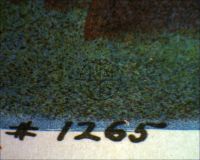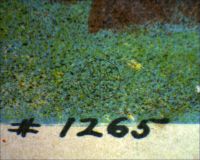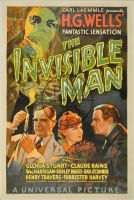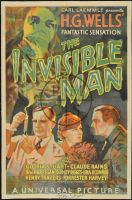THE INVISIBLE MAN
Click on image for full report. U.S. One Sheet, stone-lithograph, Universal Pictures, 1933
H.G. Wells, Carl Laemmle, Gloria Stuart, Claude Rains
Universal Horror Litho by unknown (probably Morgan), #1265
Measures: 27 3/16" x 40 15/16"
Linen backed and expertly restored.
Microscope images shown at lower right were taken directly from the "Invisible Man" one sheet in the Ron Borst collection.
H.G. Wells, Carl Laemmle, Gloria Stuart, Claude Rains
Universal Horror Litho by unknown (probably Morgan), #1265
Measures: 27 3/16" x 40 15/16"
Linen backed and expertly restored.
Microscope images shown at lower right were taken directly from the "Invisible Man" one sheet in the Ron Borst collection.
Photographed on the light table, areas of paper loss at top, right side, bottom-center and left-center are clearly visible. Noteworthy is the absence of any markings on the verso, these were most likely removed by the conservator.
Under a black light (held at the left border - this is why the area appears "blown out" by the strong light). Areas of airbrushing and restoration are seen in the border, the bandages and in the woman's hat and coat, and in the bottom image above "A UNIVERSAL PICTURE".
As a part of this evaluation, a unique silk screen tag has been added in the lower left corner margin. This imprint has been archived and documented.
A small area of print (approx. 2mm) that has been scraped from the surface in the lower right of the image. Spray from the airbrushing of the border is visible (circular white dots).
The same printing error from the Borst poster, a printing flaw appearing in the Scientist's left-hand knuckle. Indicates that the magenta on both posters was printed from the same litho stone.
The same shot from the Borst poster of Gloria Stuart's right eye. The same printed dark red dot appears at lower center of the image. This similarity indicates that the red color on both posters was printed from the same litho stone.
The same area from the Borst poster showing the same printing mark in the forehead of the Invisible Man. The similarities indicate that the cyan color from both posters was printed from the same litho stone.
The same printing irregularity appears on the Borst poster. From the lower right border, a triangular shaped black printing mark. Indicates that the black on these two posters was printed from the same litho stone.
The same area on the Borst poster. Noting the blue lines behind the Lithography numbers and the tiny red printing anomaly (below and left of the # symbol) are identical.
Procedures
Imprinted with the PMCS silk screened "fingerprint-tag". Visual evaluation using light table, black light, microscope, digital photography and microscope photography.Side-by-side comparison with a one sheet from the Ron Borst collection using photography with a digital camera [Nikon D90 with 12.3 megapixels], 50mm lens, and a microscope camera [AMSCOPE MD600E].
Consultation with the previous owner and conservator. Minor consultation with Dan Strebin and Ron Borst. Comparative examination courtesy of Ron Borst, his poster was taken off his wall, removed from it's frame and transported to our laboratory . Documentation by Lindsay Simmons and John Davis of Poster Mountain Inc.
Conclusion
This poster was neither conserved nor restored by Poster Mountain, Inc.U.S. one sheet poster mounted to a substrate of cotton canvas and Masa paper with a water soluble adhesive.
Paper losses: 5 in the top border, from left to right measuring approximately: 2.5cm, 2.5cm, 3.3cm, 3cm and a thin loss 7cm to the upper right corner.
Right border losses: upper right measuring approximately 2.5cm and at the center fold, 0.5cm.
In the lower section above the text "A UNIVERSAL PICTURE" there are approximately 4 oblong losses, the largest is in the center measuring 7cm long and 2cm high, the smaller holes are approximately 2cm each.
These losses have been filled with a compound or paper.
A tear beginning at the center fold inside the woman's hat and continues approx. 18cm to the right.
This poster was previously folded laterally 5 times and once vertically at center. Due to these folds the border in these areas is partially broken and has been in-painted.
The border has been spot-airbrushed in all areas where losses and breaks occur.
Cosmetic restoration using a combination of airbrushing and colored pencil is evident in the H, G and S, of "H. G. Wells'", the woman's hat and coat, the Invisible Man's neck bandages, in the replacement of the upper border crop marks, and in large oblong area directly above the words "A UNIVERSAL PICTURE" in the lower section.
Side-by-side comparison with the one sheet from the Ron Borst collection highlight the similarities in plate impressions as well as the differences in color depth and value. The Borst poster reflects a much lighter ink pressing with less black and more yellow. The difference in the cyan (blue) in and around the words "A UNIVERSAL PICTURE" is believed to be the result of a careful local cleaning of the litho stone during the cyan print run.
Disclaimer
The object and/or subject of this report is private property. This page is for informational purposes only. Unless clearly stated otherwise, all conservation and restoration has been performed by Poster Mountain (PM) or Los Angeles Paper Group (LAPG)I) PM-LAPG has not knowingly withheld any significant information from its evaluation report and to the best of its knowledge all statements and evaluations in this report are true and correct.
II) PM-LAPG stated in the Evaluation Report its own personal, unbiased and professional analysis, opinions and conclusions, which are subject to the assumptions and limited conditions in this evaluation report as set forth hereinabove.
III) PM-LAPG has no present or prospective interests in the property which is the subject matter of this report and it has no present or prospective personal interests or bias with respect to the participants in this matter.
IV) PM-LAPG and its employment and/or compensation for performing this evaluation or any future anticipated evaluation was not conditioned on any agreement or understanding, written or otherwise, that it would report (or present analysis in support) as predetermined specific authenticity, a predetermined evaluation that favors the cause of any party or the attainment of any specific result or occurrence of a specific subsequent event, such as value or marketability.
V) PM-LAPG prepared all opinions and conclusions about the subject property that were set forth in this Evaluation Report. If it has relied on significant evaluation assistance from any individual or individuals in the performance of this evaluation or the appropriation of this evaluation report, PM-LAPG has named such individuals and disclosed the specific task performed in this evaluation report. PM-LAPG certifies that any individual so named is qualified to the same extent as PM to perform the task. PM-LAPG has not authorized anyone to make a change to any item in this evaluation report, therefore, any change made to this evaluation is unauthorized and PM-LAPG will not take responsibility for it.
VI) The Client may not disclose or distribute this Evaluation Report to any potential purchasers of the subject property without first obtaining PM-LAPG's prior written consent. This consent must be obtained before this evaluation report may be disclosed or distributed to any other party, including, but not limited to, the public through advertising, public relations, news, sales, or other media.
